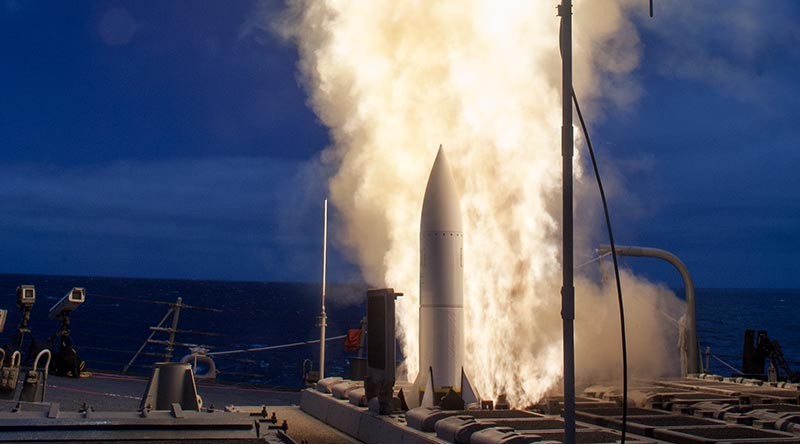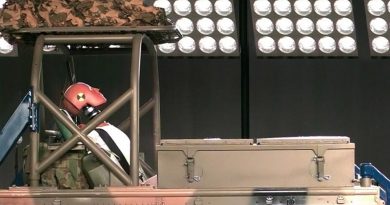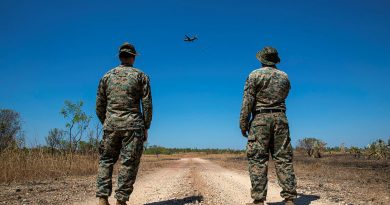SM-6 shatters [secret] engagement distance record
Share the post "SM-6 shatters [secret] engagement distance record"

Before we get into today’s SM-6 press releases, I want to give Raytheon a slap up side the head for their headline (above, with the word secret added by me) when they didn’t tell us either the new record or the old record – because that information is classified.
So my point is, if it’s classified info that you can’t tell us about, why trumpet about it in a headline!
PHOTO CAPTION: 2014 US Navy file photo – Arleigh-Burke class guided-missile destroyer USS John Paul Jones launches a Standard Missile 6 during a live-fire test of the ship’s aegis weapons system.
Raytheon’s two press releases today read…..
Flight test validates missile’s combat effectiveness
PACIFIC MISSILE RANGE FACILITY, Hawaii, March 7, 2016 /PRNewswire/ — Raytheon’s Standard Missile-6, successfully engaged five targets and shattered its previous maximum engagement range record, set in June of 2014.
This test series, supported by the Cooperative Engagement Capability, validated the tactical warfighting capability of the missile, by demonstrating both maximum down range and a maximum cross range intercepts in over-the-horizon, engage-on-remote missions.
“These tests demonstrate the full warfighting potential of SM-6 and its proven multi-mission value,” said Dr. Taylor Lawrence, Raytheon Missile Systems president.
“The versatility of SM-6 makes it deployable on 60 surface combatants in the fleet, providing additional layers of capability and protection.”
The USS JOHN PAUL JONES (DDG 53), configured with AEGIS Baseline 9.C1, executed the series of four missions with five SM-6 missiles for Follow-on Operational Test and Evaluation, part of the final testing leading to a likely declaration of Full Operational Capability in 2017.
The USS GRIDLEY (DDG 101) was on station to perform as the AEGIS assist ship for the engage-on-remote missions. The tests also proved the ability of SM-6 to conduct complex, multiple target scenarios.
SM-6 is a key component of the U.S. Navy’s Naval Integrated Fire Control – Counter Air mission, providing U.S. Navy sailors and their vessels extended range protection against fixed and rotary-wing aircraft, unmanned aerial vehicles, cruise and ballistic missiles.
The SM-6 deployed for the first time in 2013, and Raytheon has delivered more than 250 missiles. The missile’s final assembly takes place at Raytheon’s state-of-the-art SM-6 and SM-3 all-up-round production facility at Redstone Arsenal in Huntsville, Ala.
SM-6 air defense interceptor proves surface-to-surface engagement capability
PACIFIC MISSILE RANGE FACILITY, Hawaii, Mar. 7, 2016 /PRNewswire/ — Raytheon Company’s (NYSE: RTN) Standard Missile-6 (SM-6) successfully engaged a surface target — the decommissioned USS Reuben James (FFG 57) — in a recent flight test. The test was a demonstration of the U.S. Navy’s concept of “distributed lethality,” employing ships in dispersed formations to increase the offensive might of the surface force and enabling future options for the joint force commander. The USS John Paul Jones fired the SM-6 during the test; another Air Defense Arleigh Burke Class Destroyer was on station as the assist ship.
The mission validated that the legacy Anti-Surface Warfare (ASUW) capability of the Standard Missile-2 family of missiles and the MK7 Aegis Weapon System (AWS) has successfully carried over to SM-6 and the latest Aegis Destroyer baseline 9. The investment in the Standard Missile family resulted in an affordable SM-6 effector that continues to perform beyond expectations.
“This test event demonstrated Raytheon’s decades of continued technological development and partnership with the U.S. Navy,” said Dr. Taylor Lawrence, Raytheon Missile Systems president. “The ability to leverage the Standard Missile Family and the legacy AWS in newly fielded systems brings additional warfighting capability to the U.S. Fleet.”
In recent testing, SM-6 has shown expanded mission capability in three key areas: Anti-Air Warfare, Sea-Based Terminal and Anti-Surface Warfare. The tri-mission capability of SM-6 continues to emphasize its value by providing additional capability beyond its original intended mission.
Raytheon has delivered more than 250 SM-6 missiles, which were deployed for the first time in 2013. The missile’s final assembly takes place at Raytheon’s state-of-the-art SM-6 and SM-3 all-up-round production facility at Redstone Arsenal in Huntsville, Ala.
US Navy awards Raytheon $270 million contract for Standard Missile-6 production
TUCSON, Ariz., March 8, 2016 /PRNewswire/ — The U.S. Navy awarded Raytheon Company $270 million to exercise fiscal 2016 options for Standard Missile-6 production and spares requirements.
“US Navy commanders want both capability and flexibility to meet a wide variety of missions, and that’s exactly what SM-6 offers,” said Mike Campisi, Standard Missile-6 senior program director. “Its use is transforming defense.”
Raytheon has delivered more than 250 missiles to the U.S. Navy, which deployed SM-6 for the first time in 2013.
In recent testing, SM-6 has shown expanded mission capability in three key areas: Anti-Air Warfare, Sea-Based Terminal and Anti-Surface Warfare. The tri-mission capability of SM-6 continues to emphasize its value by providing additional capability beyond its original intended mission.
The final assembly of SM-6 takes place at Raytheon’s state-of-the-art production facility at Redstone Arsenal in Huntsville, Ala.
About the Standard Missile-6
SM-6 delivers a proven over-the-horizon air defense capability by leveraging the time-tested advantages of the Standard Missile’s airframe and propulsion.
- The SM-6 uses both active and semiactive guidance modes and advanced fuzing techniques.
- It incorporates the advanced signal processing and guidance control capabilities from Raytheon’s Advanced Medium-Range Air-to-Air Missile.
- SM-6 delivers multi-mission capability for long range Fleet Air Defense and Sea-Based Terminal Defense
About the Cooperative Engagement Capability
Cooperative Engagement Capability (CEC) is a real-time sensor netting system that enables high quality situational awareness and integrated fire control capability, improving battle force effectiveness and enabling longer range, cooperative, multiple, or layered engagement strategies. Currently deployed on 75 naval ships and 48 aircraft, 10 U.S. Marine Corps network systems, and approved for export to four countries, CEC continues to evolve, benefitting from developments in core technologies, which have advanced the system in both capability and affordability.
P.S. Google searches put the SM-6 missile’s range at anywhere from 150 nautical miles to 250+ nautical miles. But, I saw one US DoD source quoted as saying “greater than 200 nautical miles” = 370km.
.
.

.
.
Share the post "SM-6 shatters [secret] engagement distance record"







